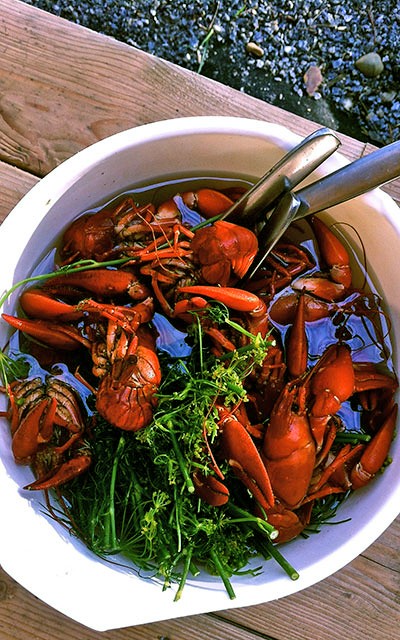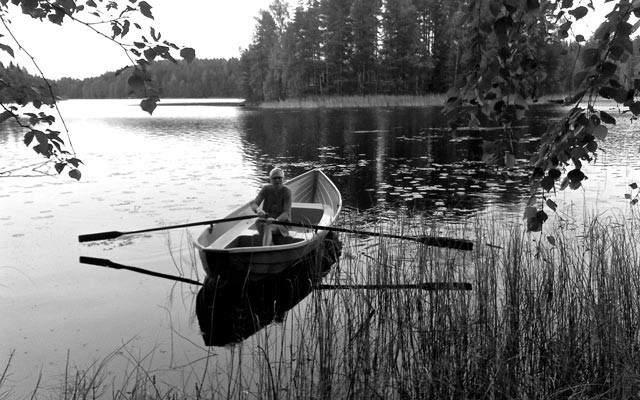In southeast Finland, lakes don't so much dot the land as streak it. Trending northwest-southeast, they pool in bedrock furrows raked by the Pleistocene ice sheets, interconnecting via swampy capillaries occasionally pinched off by the still, slowly rising land. The lake district is Finland's largest geographic region, bounded to the south by the Salpausselkä Ridges — several-hundred-kilometre-long terminal moraines, behind which extends the watery networks and a heavily forested countryside dominated by further glacial remnants like drumlins and long, sinuous eskers.
This landscape extends east into Russia, which means there's no natural border and sometimes only a vague sense of which country is which. Likewise, with no set definition of what constitutes a lake, no one can say precisely how many are located here, though aerial topography shows 55,000 or so of at least 200 metres across. Lake Saimaa, with a surface area of 4,400 square kilometres, is Finland's largest lake and Europe's fourth so, a riverine labyrinth of bays and some 14,000 islands adding up to 15,000 km of total shoreline — more per unit area than anywhere else in the world. It's a veritable Euro-version of Ontario/Minnesota's Lake of the Woods — an apt analogy given that geographically, the region's most obvious landscape analog is the vast swath of central Ontario and Quebec known to its denizens as Lake Country. No surprise then that Finland's lake country also supports a cottage culture which in many respects is similar to Eastern Canada's — though not in every way.
To start, the waters lap at similarly exposed rocky points and islands of Precambrian rock, onshore a platoon of circumpolar flora and fauna that includes familiar icons like moose, beaver, lynx, mink, northern pike, perch, rainbow trout, and an assortment of birches, poplars, pines, and firs. But there are also unique animals like hedgehogs, raccoon-dog, Arctic fox, startlingly decorated forest ground birds like metso and teeri that make partridges look lame, and many other fishes more closely related to those in southern Europe and western Asia. On top of that are endangered critters like the freshwater Saimaa ringed seal and Saimaa salmon.
On the edge of Saimma is the town of Mikkeli where my partner's parents grew up before meeting, marrying and moving to Quesnel. Nearby is smallish Lake Toplanen, where her father has spent a month each summer over the past decade or so finishing up a hand-built cabin, or mökki. Raised on a farm just down the road, his three brothers also have property around the lake and still live here, each with their own mökki. The original family summerhouse was only a kilometre from their farm, and indeed mökki on these lakes are as apt to be occupied by people who live nearby as they are by weekenders from Helsinki, some three hours distant. Having a summer retreat in Finland feels more tradition than privilege, as even many of modest means have mökki (one in 10 of the country's five million citizens) — a far cry from the growing real-estate grabs of Toronto or Montreal's cottage country. As with anything, who knows how long before money pushes out tradition.

PHOTO: LESLIE ANTHONY - Crayfish, based on a recipe from Helsinki restaurant, Savoy.
For the time being, it's a beautiful, quiet lake, made more so by the welcome absence of powerboats and water-skiers, tubers or wakeboarders. Instead, folks have small rowboats, with outboards of 10 hp or less which they never run full out. It's rare to even hear one and so truly possible to relax fully into nature. Furthermore, the lake's character is preserved as Finns don't feel the need to raze trees to the water or overly alter shorelines, such that mökki huddle behind forest palisades, their shores protected from erosion by the natural water plants that still grow in the shallows. Docks are small, and usually used for a fishing cast or plunge after the daily ritual of sauna, which is always in a separate structure with lakeside precedence. The more bucolic, natural feel is furthered by the Finns' love of privacy and the fact that they don't need to be out on a deck or dock all day having a party, also the norm in Canada. Which isn't to say no one ever visits — like when my partner's cousin brought us some crayfish.
Boats creep daily along the shore checking traps marked by homemade Styrofoam buoys grouped in threes where the bottom is good for crayfish — knowledge honed through the kind of trial-and-error employed by hunters of any species of animal. One of my partner's uncles is known as the Crayfish Baron around the lake, and one evening as the sun began its slow descent over the trees, her cousin arrived with the gift of a bowl of bright-red cooked crayfish, based on a recipe from Savoy, a famous Helsinki restaurant, which involved a heavy infusion of dill to obviate the occasionally muddy flavour of these bottom-dwellers. You eat them like Louisiana crawdads, spreading paper out on the table, cracking the claws and carefully withdrawing the muscular morsels, then tearing off the tail and wresting out this more substantial food item. It's a lot of work, but really more of a social event and excuse for a few shots of vodka.
Finally, much like Ontario, it had been hellishly hot and humid when we'd arrived, the upper lake waters rendered soupy by temperatures that climbed daily into the 30s. By the second week in August, however, the worm had turned, the rain storms rolling in across the Gulf of Bothnia separating Finland from Norway and Sweden delivering thunder, wind and steadily decreasing temperatures to create both morning fog and a lake now much cooler to jump into after the daily sauna. The air was full of summer's last sigh, and the quiet, therapeutic memories of each mökki spun like spindrift down the highway with its retreating owners.
Leslie Anthony is a Whistler-based author, editor, biologist and bon vivant who has never met a mountain he didn't like.




